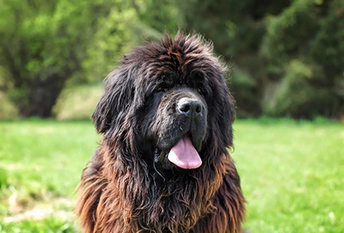The Great Pyrenees has a beautiful double coat of white or white with markings of gray, badger, reddish brown or any shade of tan. The coat sheds dirt and resists forming mats or tangles, but there is a lot of it. Expect to spend approximately 30 minutes weekly brushing it to remove dead hair and keep it clean and healthy. Pyrs do shed, so regular brushing will help reduce the number of white hairs floating around your house.
Check the ears on a weekly basis for signs of infection, irritation, or wax build up. Cleanse regularly with a veterinarian-approved cleanser and cotton ball. Brush the teeth at least once per week to prevent tartar buildup and fight gum disease. Additionally, nails should be trimmed once per month if the dog does not wear down the toenails naturally.
Because this breed is used to being able to roam about freely and constantly being on the go, the Great Pyrenees will be happiest if it gets a lot of daily exercise. If you leave your dog alone, it will just run around happily all day. When taking your dog for a walk or run, be sure to keep it on a strong lease, or else it may try to make a break for it.
When working, they will patrol their territory but tend to conserve their energy for fending off whatever may threaten their flock. Moderateexercisesuch as walks with their owner will help keep them healthy and happy. The breed also exercises the mind and body by participating in canine activities such asobedience trialsand cart-pulling.
For a large dog, the Great Pyrenees has a moderate appetite. In fact, you’ll find that feeding your poochis no different than most other dogs. Feed your dog a well-balanced and quality dog food with quality ingredients, which will help develop and maintain good health and a shiny coat.
“Of course, if another dog wants what’s in their bowl, they will snarf down the food like they hadn’t eaten in months,” says one breed devotee. High-quality dry dog foodthat is low-protein and specially formulated for large breeds is a good idea. The breed is susceptible tobloat, or gastric dilatation-volvulus (GDV), where the stomach distends and twists. The causes of bloat aren’t fully understood, but experts agree that multiple, small meals per day and preventing vigorous exercise around mealtimes may help reduce the chances of it happening.
The average life span of the Great Pyrenees is 10 to 12 years.When working, they will patrol their territory but tend to conserve their energy for fending off whatever may threaten their flock. Moderateexercisesuch as walks with their owner will help keep them healthy and happy. The breed also exercises the mind and body by participating in canine activities such asobedience trialsand cart-pulling.
Breed health concerns may includebloat (gastric dilatation and volvulus), tricuspid valve dysplasia,degenerative myelopathy,congenital deafness, elbow, andhip dysplasia, shoulder osteochondrosis, factor XI deficiency, osteosarcoma,entropion,ectropion,progressive retinal atrophy, and assortedskin problems.
The Great Pyrenees is very sensitive to the tone of its trainer’s voice. Training must be calm, consistent, and patient, but Great Pyrenees will be obedient once trained. They may run away off the leash, so proper precautions should be taken.
When training Great Pyrenees, it’s important to note that this breed prefers to be treated as an equal. This means that it will be more responsive to training if it is allowed to be involved in the process rather than being told what to do. This is an intelligent dog, so don’t try to outsmart it – it could result in a stubborn dog.
You want a dog that listens and is well behaved, and training will go a long way in providing that. You may find that the Great Pyrenees’ large size and independent streak can make training stressful, but with the right approach, it will be an easier process to train your Great Pyrenees.











